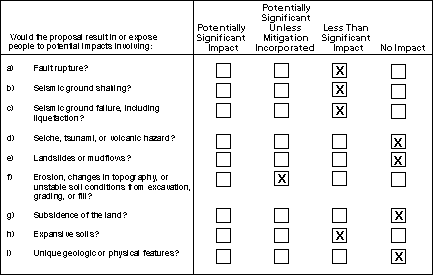
The proposed project area lies on an alluvial fan along the northeast margin of the Santa Cruz Mountains, at the base of Monte Bello Ridge. The elevations range from approximately 400 feet at the Monta Vista substation to 165 feet at the Wolfe substation. The Monta Vista, Stelling and Wolfe substations, as well as the transmission line easements, are located in previously developed areas that have been graded and are essentially flat.
The San Andreas and Berrocal Fault Zones and the Monta Vista fault lie in closest proximity to the project area. The San Andreas is an active fault and the Monta Vista and Berrocal are considered potentially active. The San Andreas is located 4.5 miles from the project area and extends through the Santa Cruz Mountains. The Monta Vista fault and the Berrocal Fault Zone lie within two miles of the project area and trend northwest along the eastern foothills of the Santa Cruz Mountains. The San Andreas Fault Zone and Monta Vista fault exhibit relative horizontal movement in an earthquake while the Berrocal Fault Zone can exhibit vertical displacement.
Faults with the greatest potential for ground-surface rupture are those considered active by the state of California and which are zoned under the Alquist-Priolo Earthquake Fault Zoning Act. In the vicinity of the project area, the San Andreas Fault Zone is active, and could experience surface displacement in the event of an earthquake on its peninsula segment. The project area is not located within the fault rupture hazard zone for the San Andreas Fault Zone. Considering the distance from the San Andreas Fault Zone, there is a low potential that ground-surface rupture would occur in the project area during a San Andreas Fault Zone earthquake. It is possible that San Andreas Fault Zone activity could trigger secondary movement and possibly ground-surface rupture on the Monta Vista fault and in Berrocal Fault Zone. However, considering the distance of these faults, the potential for ground-surface rupture occurring is remote.
The project site is located in the Santa Cruz Range foothills in the Coast Range Geomorphic Province, which is an area of high seismic activity. Several major northwest-trending faults, (especially the dominant San Andreas Fault Zone) and a number of smaller fault zones located within 40 miles, are anticipated to generate major earthquakes that could induce significant ground shaking in the project area. In addition to the San Andreas, the Monta Vista Fault and the Berrocal Fault Zone, other active and potentially active faults are listed in Table III-1.
The main potential hazard to structures and people on site would be from ground movement associated with seismic activity. Because the substations would be fenced and locked, direct public access would be prevented. Therefore, no injuries to people on the substation properties would be expected to occur during earthquakes. Damage to PG&E power poles and lines from ground shaking is not anticipated. Although local surface failures can cause collapse of poles, evidence of unstable soils or slopes were either not identified or corrected prior to construction of the existing pole locations. The earthquake hazards are potentially significant only for the facilities themselves. To the extent that these would be rendered inoperable by an earthquake, resulting in a loss of power in the service area, the project could affect population in the service area. However, a major earthquake that could affect proposed project components also is likely to affect a wide area in the South Bay. By providing better linkage of power transmission in the area, the project likely would result in a net improvement to system reliability during and following a major earthquake.
PG&Eís overhead and underground electrical facilities are constructed to exceed the safety standards established in the Commissionís General Orders, which generally far exceed the seismic load required to sustain a maximum credible earthquake. For example, utility poles built in accordance with General Order 95 are generally more than twice as strong as
required to withstand the seismic load of a maximum credible earthquake. Compliance with these and the California Building Code would reduce groundshaking effects to levels of acceptable risk, and would result in a less than significant impact from groundshaking (PG&E, 1998).
TABLE III-1
LOCATIONS AND CHARACTERISTICS OF EARTHQUAKE FAULTS
THAT MAY AFFECT THE PROPOSED MONTA VISTA SITE